英语一阅读翻译2012
- 格式:doc
- 大小:28.62 KB
- 文档页数:7
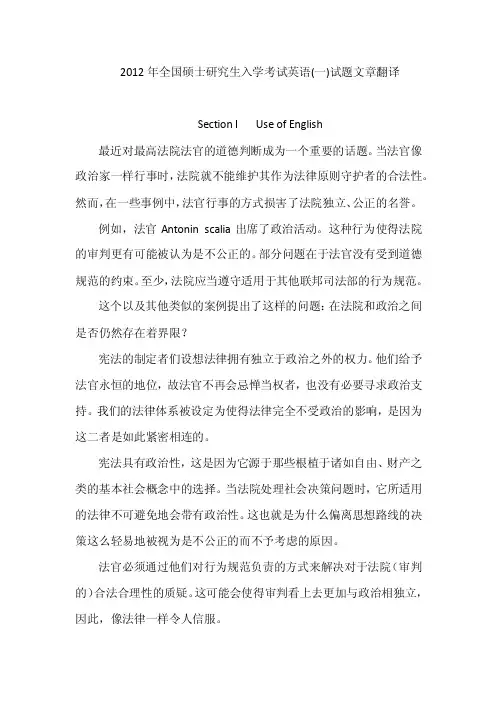
2012年全国硕士研究生入学考试英语(一)试题文章翻译Section I Use of English最近对最高法院法官的道德判断成为一个重要的话题。
当法官像政治家一样行事时,法院就不能维护其作为法律原则守护者的合法性。
然而,在一些事例中,法官行事的方式损害了法院独立、公正的名誉。
例如,法官Antonin scalia出席了政治活动。
这种行为使得法院的审判更有可能被认为是不公正的。
部分问题在于法官没有受到道德规范的约束。
至少,法院应当遵守适用于其他联邦司法部的行为规范。
这个以及其他类似的案例提出了这样的问题:在法院和政治之间是否仍然存在着界限?宪法的制定者们设想法律拥有独立于政治之外的权力。
他们给予法官永恒的地位,故法官不再会忌惮当权者,也没有必要寻求政治支持。
我们的法律体系被设定为使得法律完全不受政治的影响,是因为这二者是如此紧密相连的。
宪法具有政治性,这是因为它源于那些根植于诸如自由、财产之类的基本社会概念中的选择。
当法院处理社会决策问题时,它所适用的法律不可避免地会带有政治性。
这也就是为什么偏离思想路线的决策这么轻易地被视为是不公正的而不予考虑的原因。
法官必须通过他们对行为规范负责的方式来解决对于法院(审判的)合法合理性的质疑。
这可能会使得审判看上去更加与政治相独立,因此,像法律一样令人信服。
Section II Reading ComprehensionPart AText 1“来吧,每个人都在这么做。
”这个半邀请半强迫的耳语似的信息,是大部分人在听到“同龄压力”这个词语时所想到的。
这个词语常常会导致不好的事情,如酗酒、嗑药和滥交。
但在她的新书——《加入俱乐部》中,Tina Rosenberg认为通过她所称之为的社会疗法,同龄压力也可以成为一种正面的力量。
在这种社会疗法中,机构和官员利用集体动态的力量来帮助个人改善他们的生活,并且可能改变这个世界。
普利策奖的获得者,Rosenberg提供了许多正在进行中的社会疗法的例子:在南卡罗来纳州,一个名为“Rage Against the Haze”(愤怒面对烟雾)的由政府发起的禁烟行动,决心使得香烟不再受人欢迎。
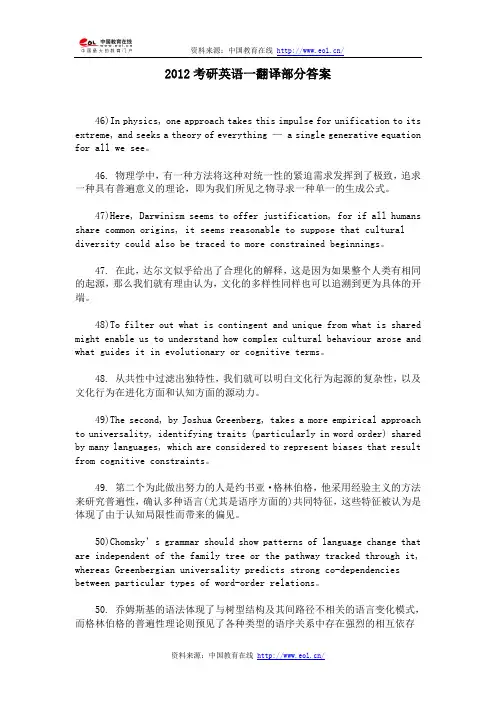
2012考研英语一翻译部分答案46)In physics, one approach takes this impulse for unification to its extreme, and seeks a theory of everything — a single generative equation for all we see。
46. 物理学中,有一种方法将这种对统一性的紧迫需求发挥到了极致,追求一种具有普遍意义的理论,即为我们所见之物寻求一种单一的生成公式。
47)Here, Darwinism seems to offer justification, for if all humans share common origins, it seems reasonable to suppose that cultural diversity could also be traced to more constrained beginnings。
47. 在此,达尔文似乎给出了合理化的解释,这是因为如果整个人类有相同的起源,那么我们就有理由认为,文化的多样性同样也可以追溯到更为具体的开端。
48)To filter out what is contingent and unique from what is shared might enable us to understand how complex cultural behaviour arose and what guides it in evolutionary or cognitive terms。
48. 从共性中过滤出独特性,我们就可以明白文化行为起源的复杂性,以及文化行为在进化方面和认知方面的源动力。
49)The second, by Joshua Greenberg, takes a more empirical approach to universality, identifying traits (particularly in word order) shared by many languages, which are considered to represent biases that result from cognitive constraints。
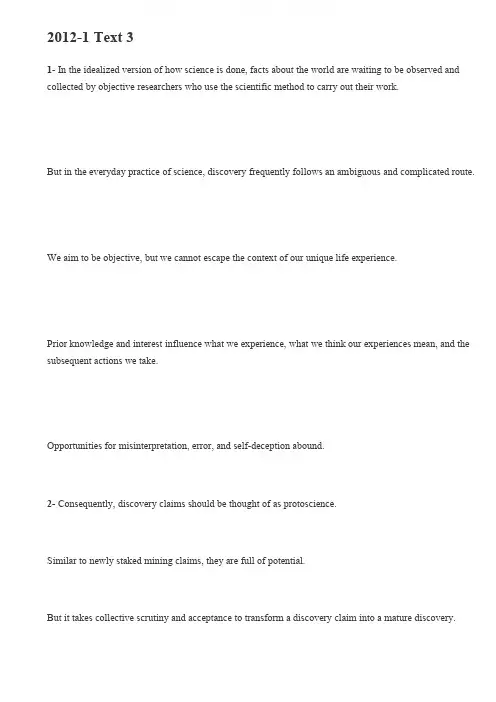
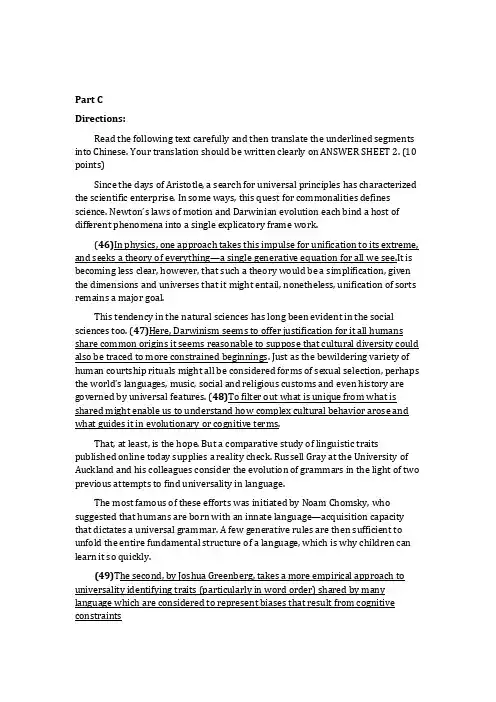
Part CDirections:Read the following text carefully and then translate the underlined segments into Chinese. Your translation should be written clearly on ANSWER SHEET 2. (10 points)Since the days of Aristotle, a search for universal principles has characterized the scientific enterprise. In some ways, this quest for commonalities defines science. Newton’s laws of motion and Darwinian evolution each bind a host of different phenomena into a single explicatory frame work.(46)In physics, one approach takes this impulse for unification to its extreme, and seeks a theory of everything—a single generative equation for all we see.It is becoming less clear, however, that such a theory would be a simplification, given the dimensions and universes that it might entail, nonetheless, unification of sorts remains a major goal.This tendency in the natural sciences has long been evident in the social sciences too. (47)Here, Darwinism seems to offer justification for it all humans share common origins it seems reasonable to suppose that cultural diversity could also be traced to more constrained beginnings. Just as the bewildering variety of human courtship rituals might all be considered forms of sexual selection, perhaps the world’s languages, music, social and religious customs and even history are governed by universal features. (48)To filter out what is unique from what is shared might enable us to understand how complex cultural behavior arose and what guides it in evolutionary or cognitive terms.That, at least, is the hope. But a comparative study of linguistic traits published online today supplies a reality check. Russell Gray at the University of Auckland and his colleagues consider the evolution of grammars in the light of two previous attempts to find universality in language.The most famous of these efforts was initiated by Noam Chomsky, who suggested that humans are born with an innate language—acquisition capacity that dictates a universal grammar. A few generative rules are then sufficient to unfold the entire fundamental structure of a language, which is why children can learn it so quickly.(49)The second, by Joshua Greenberg, takes a more empirical approach to universality identifying traits (particularly in word order) shared by many language which are considered to represent biases that result from cognitive constraintsGray and his colleagues have put them to the test by examining four family trees that between them represent more than 2,000 languages.(50)Chomsky’s grammar should show patterns of language change that are independent of the family tree or the pathway tracked through it. Whereas Greenbergian universality predicts strong co-dependencies between particular types of word-order relations. Neither of these patterns is borne out by the analysis, suggesting that the structures of the languages are lire age-specific and not governed by universals.翻译46. 在物理学领域,有一种方法将这种“万物归一的冲动”推向了极致,它试图探寻到能解释一切的,最底层的公式。
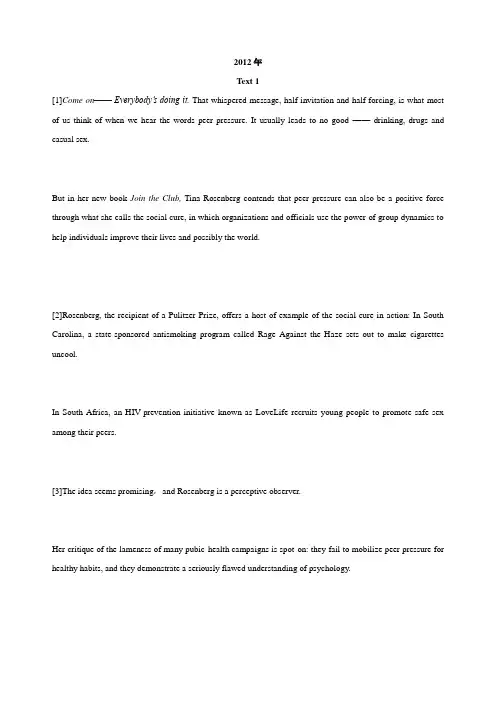
2012年Text 1[1]Come on——Everybody’s doing it. That whispered message, half invitation and half forcing, is what most of us think of when we hear the words peer pressure. It usually leads to no good ——drinking, drugs and casual sex.But in her new book Join the Club, Tina Rosenberg contends that peer pressure can also be a positive force through what she calls the social cure, in which organizations and officials use the power of group dynamics to help individuals improve their lives and possibly the world.[2]Rosenberg, the recipient of a Pulitzer Prize, offers a host of example of the social cure in action: In South Carolina, a state-sponsored antismoking program called Rage Against the Haze sets out to make cigarettes uncool.In South Africa, an HIV-prevention initiative known as LoveLife recruits young people to promote safe sex among their peers.[3]The idea seems promising,and Rosenberg is a perceptive observer.Her critique of the lameness of many pubic-health campaigns is spot-on: they fail to mobilize peer pressure for healthy habits, and they demonstrate a seriously flawed understanding of psychology.“Dare to be different, please don’t smoke!” pleads one billboard campaign aimed at reducing smoking among teenagers —— teenagers, who desire nothing more than fitting in.Rosenberg argues convincingly that public-health advocates ought to take a page from advertisers, so skilled at applying peer pressure.[4]But on the general effectiveness of the social cure, Rosenberg is less persuasive.Join the Club is filled with too much irrelevant detail and not enough exploration of the social and biological factors that make peer pressure so powerful.The most glaring flaw of the social cure as it’s presented here is that it doesn’t w ork very well for very long.Rage Against the Haze failed once state funding was cut.Evidence that the LoveLife program produces lasting changes is limited and mixed.[5]There’s no doubt that our peer groups exert enormous influence on our behavior.An emerging body of research shows that positive health habits——as well as negative ones——spread through networks of friends via social communication.This is a subtle form of peer pressure: we unconsciously imitate the behavior we see every day.[6]Far less certain, however, is how successfully experts and bureaucrats can select our peer groups and steer their activities in virtuous directions.It's like the teacher who breaks up the troublemakers in the back row by pairing them with better-behaved classmates.The tactic never really works. And that's the problem with a social cure engineered from the outside: in the real world, as in school, we insist on choosing our own friends.21. According to the first paragraph, peer pressure often emerges as[A] a supplement to the social cure[B] a stimulus to group dynamics[C] an obstacle to school progress[D] a cause of undesirable behaviors22. Rosenberg holds that public-health advocates should[A] recruit professional advertisers[B] learn fr om advertisers’ experience[C] stay away from commercial advertisers[D] recognize the limitations of advertisements23. In the author’s view, Rosenberg’s book fails to[A] adequately probe social and biological factors[B] effectively evade the flaws of the social cure[C] illustrate the functions of state funding[D] produce a long-lasting social effect24. Paragraph 5 shows that our imitation of behaviors[A] is harmful to our networks of friends[B] will mislead behavioral studies[C] occurs without our realizing it[D] can produce negative health habits25. The author suggests in the last paragraph that the effect of peer pressure is[A] harmful [B] desirable [C] profound [D] questionableText 2[1]A deal is a deal——except, apparently, when Entergy is involved.The company, a major energy supplier in New England, provoked justified outrage in V ermont last week when it announced it was reneging on a longstanding commitment to abide by the strict nuclear regulations.[2]Instead, the company has done precisely what it had long promised it would not: challenge the constitutionality of V ermont’s rules in federal court, as part of a desperate effort to keep its Vermont Yankee nuclear po wer plant running. It’s a stunning move.[3]The conflict has been surfacing since 2002, when the corporation bought V ermont’s only nuclear power plant, an aging reactor in V ernon.As a condition of receiving state approval for the sale, the company agreed to seek permission from state regulators to operate past 2012.In 2006, the state went a step further, requiring that any extension of the plant’s license be subject to V ermont legislature’s approval. Then, too, the company went along.[4]Either Entergy never really intended to live by those commitments, or it simply didn’t foresee what would happen next.A string of accidents, including the partial collapse of a cooling tower in 2007 and the discovery of an underground pipe system leakage, ra ised serious questions about both Vermont Yankee’s safety and Entergy’s management——especially after the company made misleading statements about the pipe.Enraged by Entergy’s behavior, the V ermont Senate voted 26 to 4 last year against allowing an ex tension.[5]Now the company is suddenly claiming that the 2002 agreement is invalid because of the 2006 legislation, and that only the federal government has regulatory power over nuclear issues.The legal issues in the case are obscure: whereas the Supreme Court has ruled that states do have some regulatory authority over nuclear power, legal scholars say that V ermont case will offer a precedent-setting test of how far those powers extend.Certainly, there are valid concerns about the patchwork regulations that could result if every state sets its own rules. But had Entergy kept its word, that debate would be beside the point.[6]The company seems to have concluded that its reputation in Vermont is already so damaged that it has nothing left to lose by going to war with the state. But there should be consequences.Permission to run a nuclear plant is a public trust. Entergy runs 11 other reactors in the United States, including Pilgrim Nuclear station in Plymouth.Pledging to run Pilgrim safely, the company has applied for federal permission to keep it open for another 20 years.But as the Nuclear Regulatory Commission (NRC) reviews the company’s application, it should keep i n mind what promises from Entergy are worth.26. The phrase “reneging on”(Line 3.para.1) is closest in meaning to[A] condemning.[B] reaffirming.[C] dishonoring.[D] securing.27. By entering into the 2002 agreement, Entergy intended to[A] obtain protection from Vermont regulators.[B] seek favor from the federal legislature.[C] acquire an extension of its business license .[D] get permission to purchase a power plant.28. According to Paragraph 4, Entergy seems to have problems with its[A] managerial practices.[B] technical innovativeness.[C] financial goals.[D] business vision29. In the author’s view, the Vermont case will test __________[A] Entergy’s capacity to fulfill all its promises.[B] the n ature of states’ patchwork regulations.[C] the federal authority over nuclear issues.[D] the limits of states’ power over nuclear issues.30. It can be inferred from the last paragraph that[A] Entergy’s business elsewhere might be affected.[B] the authority of the NRC will be defied.[C] Entergy will withdraw its Plymouth application.[D] V ermont’s reputation might be damaged.Text 3[1]In the idealized version of how science is done, facts about the world are waiting to be observed and collected by objective researchers who use the scientific method to carry out their work.But in the everyday practice of science, discovery frequently follows an ambiguous and complicated route.We aim to be objective, but we cannot escape the context of our unique life experience.Prior knowledge and interest influence what we experience, what we think our experiences mean, and the subsequent actions we take. Opportunities for misinterpretation, error, and self-deception abound.[2]Consequently, discovery claims should be thought of as protoscience. Similar to newly staked mining claims, they are full of potential.But it takes collective scrutiny and acceptance to transform a discovery claim into a mature discovery.This is the credibility process, through which the individual researcher’s me, here, now becomes the community’s anyone, anywhere, anytime. Objective knowledge is the goal, not the starting point.[3]Once a discovery claim becomes public, the discoverer receives intellectual credit.But, unlike with mining claims, the community takes control of what happens next.Within the complex social structure of the scientific community, researchers make discoveries; editors and reviewers act as gatekeepers by controlling the publication process; other scientists use the new finding to suit their own purposes; and finally, the public (including other scientists) receives the new discovery and possibly accompanying technology.As a discovery claim works its way through the community, the interaction and confrontation between shared and competing beliefs about the science a nd the technology involved transforms an individual’s discovery claim into the community’s credible discovery.[4]Two paradoxes exist throughout this credibility process. First, scientific work tends to focus on some aspect of prevailing knowledge that is viewed as incomplete or incorrect.Little reward accompanies duplication and confirmation of what is already known and believed. The goal is new-search, not re-search.Not surprisingly, newly published discovery claims and credible discoveries that appear to be important and convincing will always be open to challenge and potential modification or refutation by future researchers.Second, novelty itself frequently provokes disbelief. Nobel Laureate and physiologist Albert Azent-Gyorgyi once de scribed discovery as “seeing what everybody has seen and thinking what nobody has thought.”But thinking what nobody else has thought and telling others what they have missed may not change their views. Sometimes years are required for truly novel discovery claims to be accepted and appreciated.[5]In the end, credibility “happens” to a discovery claim –a process that corresponds to what philosopher Annette Baier has described as the commons of the mind.“We reason together, challenge, revise, and complete each other’s reasoning and each other’s conceptions of reason.”31. According to the first paragraph, the process of discovery is characterized by its[A] uncertainty and complexity.[B] misconception and deceptiveness.[C] logicality and objectivity.[D] systematicness and regularity.32. It can be inferred from Paragraph 2 that credibility process requires[A] strict inspection.[B] shared efforts.[C] individual wisdom.[D] persistent innovation.33.Paragraph 3 shows that a discovery claim becomes credible after it[A] has attracted the attention of the general public.[B] has been examined by the scientific community.[C] has received recognition from editors and reviewers.[D] has been frequently quoted by peer scientists.34. Albert Szent-Györgyi would most likely agree that[A] scientific claims will survive challenges.[B] discoveries today inspire future research.[C] efforts to make discoveries are justified.[D] scientific work calls for a critical mind.35.Which of the following would be the best title of the test?[A] Novelty as an Engine of Scientific Development.[B] Collective Scrutiny in Scientific Discovery.[C] Evolution of Credibility in Doing Science.[D]Challenge to Credibility at the Gate to Science.Text 4[1]If the trade unionist Jimmy Hoffa were alive today, he would probably represent civil servant.When Hoffa’s Teamsters were in their prime in 1960, only one in ten American government workers belonged to a union; now 36% do.In 2009 th e number of unionists in America’s public sector passed that of their fellow members in the private sector. In Britain, more than half of public-sector workers but only about 15% of private-sector ones are unionized.[2]There are three reasons for the public-sector unions’ thriving. First, they can shut things down without suffering much in the way of consequences.Second, they are mostly bright and well-educated. A quarter of America’s public-sector workers have a university degree. Third, they now dominate left-of-centre politics.Some of their ties go back a long way. Britain’s Labor Party, as its name implies, has long been associated with trade unionism. Its current leader, Ed Miliband, owes his position to votes from public-sector unions.[3]At the state level their influence can be even more fearsome. Mark Baldassare of the Public Policy Institute of California points out that much of the state’s budget is patrolled by unions.The teachers’ unions keep an eye on schools, the CCPOA o n prisons and a variety of labor groups on health care.[4]In many rich countries average wages in the state sector are higher than in the private one. But the real gains come in benefits and work practices.Politicians have repeatedly “backloaded” pub lic-sector pay deals, keeping the pay increases modest but adding to holidays and especially pensions that are already generous.[5]Reform has been vigorously opposed, perhaps most egregiously in education, where charter schools, academies and merit pay all faced drawn-out battles.Even though there is plenty of evidence that the quality of the teachers is the most important variable, teachers’ unions have fought against getting rid of bad ones and promoting good ones.[6]As the cost to everyone else has become clearer, politicians have begun to clamp down.In Wisconsin the unions have rallied thousands of supporters against Scott Walker, the hardline Republican governor. But many within the public sector suffer under the current system, too.[7]John Donahue at Harvard’s Kennedy School points out that the norms of culture in Western civil services suit those who want to stay put but is bad for high achievers.The only American public-sector workers who earn well above $250,000 a year are university sports coaches and the president of the United States. Bankers’ fat pay packets have attracted much criticism, but a public-sector system that does not reward high achievers may be a much bigger problem for America.36. It can be learned from the first paragraph that[A] Teamsters still have a large body of members.[B] Jimmy Hoffa used to work as a civil servant.[C] unions have enlarged their public-sector membership.[D] the government has improved its relationship with unionists.37. Which of the following is true of Paragraph 2?[A] Public-sector unions are prudent in taking actions.[B] Education is required for public-sector union membership.[C] Labor Party has long been fighting against public-sector unions.[D]Public-sector unions seldom get in trouble for their actions.38. It can be learned from Paragraph 4 that the income in the state sector is[A] illegally secured.[B] indirectly augmented.[C] excessively increased.[D]fairly adjusted.39. The example of the unions in Wisconsin shows that unions[A] often run against the current political system.[B] can change people’s political attitudes.[C] may be a barrier to public-sector reforms.[D] are dominant in the government.40. John Don ahue’s attitude towards the public-sector system is one of[A] disapproval.[B]appreciation.[C]tolerance.[D]indifference.。
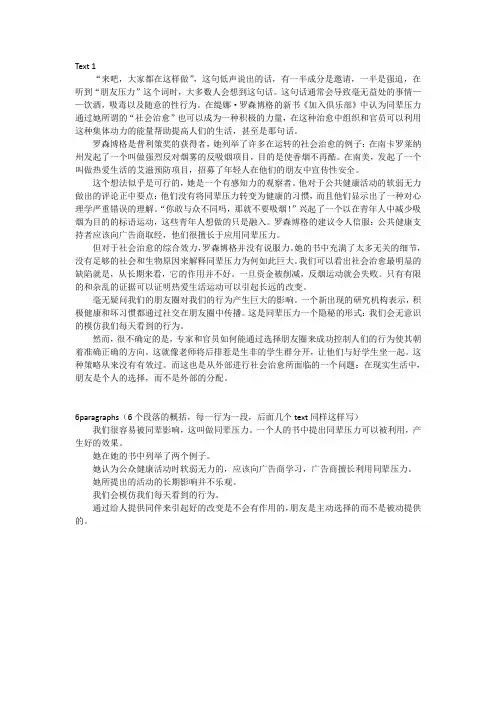
“来吧,大家都在这样做”,这句低声说出的话,有一半成分是邀请,一半是强迫,在听到“朋友压力”这个词时,大多数人会想到这句话。
这句话通常会导致毫无益处的事情——饮酒,吸毒以及随意的性行为。
在缇娜·罗森博格的新书《加入俱乐部》中认为同辈压力通过她所谓的“社会治愈”也可以成为一种积极的力量,在这种治愈中组织和官员可以利用这种集体动力的能量帮助提高人们的生活,甚至是那句话。
罗森博格是普利策奖的获得者,她列举了许多在运转的社会治愈的例子:在南卡罗莱纳州发起了一个叫做强烈反对烟雾的反吸烟项目,目的是使香烟不再酷。
在南美,发起了一个叫做热爱生活的艾滋预防项目,招募了年轻人在他们的朋友中宣传性安全。
这个想法似乎是可行的,她是一个有感知力的观察者。
他对于公共健康活动的软弱无力做出的评论正中要点:他们没有将同辈压力转变为健康的习惯,而且他们显示出了一种对心理学严重错误的理解。
“你敢与众不同吗,那就不要吸烟!”兴起了一个以在青年人中减少吸烟为目的的标语运动,这些青年人想做的只是融入。
罗森博格的建议令人信服:公共健康支持者应该向广告商取经,他们很擅长于应用同辈压力。
但对于社会治愈的综合效力,罗森博格并没有说服力。
她的书中充满了太多无关的细节,没有足够的社会和生物原因来解释同辈压力为何如此巨大。
我们可以看出社会治愈最明显的缺陷就是,从长期来看,它的作用并不好。
一旦资金被削减,反烟运动就会失败。
只有有限的和杂乱的证据可以证明热爱生活运动可以引起长远的改变。
毫无疑问我们的朋友圈对我们的行为产生巨大的影响。
一个新出现的研究机构表示,积极健康和坏习惯都通过社交在朋友圈中传播。
这是同辈压力一个隐秘的形式:我们会无意识的模仿我们每天看到的行为。
然而,很不确定的是,专家和官员如何能通过选择朋友圈来成功控制人们的行为使其朝着准确正确的方向。
这就像老师将后排惹是生非的学生群分开,让他们与好学生坐一起。
这种策略从来没有有效过。
而这也是从外部进行社会治愈所面临的一个问题:在现实生活中,朋友是个人的选择,而不是外部的分配。
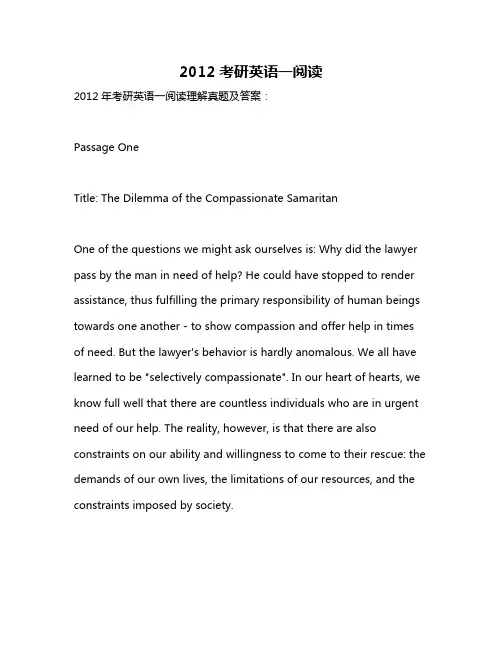
2012考研英语一阅读2012年考研英语一阅读理解真题及答案:Passage OneTitle: The Dilemma of the Compassionate SamaritanOne of the questions we might ask ourselves is: Why did the lawyer pass by the man in need of help? He could have stopped to render assistance, thus fulfilling the primary responsibility of human beings towards one another - to show compassion and offer help in times of need. But the lawyer's behavior is hardly anomalous. We all have learned to be "selectively compassionate". In our heart of hearts, we know full well that there are countless individuals who are in urgent need of our help. The reality, however, is that there are also constraints on our ability and willingness to come to their rescue: the demands of our own lives, the limitations of our resources, and the constraints imposed by society.The lawyer's indifference towards the man who lay bleeding on the side of the road is understandable, given these constraints. He was on his way to a meeting, late already, and had probably assumed that someone else would stop to assist. Besides, had he stopped, there was no guarantee that the victim would be saved. Thousands of people across the country stop every day to help those in need, and yet there are just as many cases where their efforts are unsuccessful. The lawyer may have concluded that his personal inconvenience was not worth the potential risk.However, this does not justify his behavior. The lawyer's primary responsibility was to the victim, not to himself. Helping those in need is not merely a responsibility dictated by human compassion and morality; it is also a legal obligation. The law requires individuals to render assistance when it is within their power to do so without putting their own lives in jeopardy. Therefore, even if stopping to help would have caused the lawyer some personal inconvenience, he should have done so anyway.The lesson we should learn from the story of the bleeding man on the side of the road is that we should not succumb to our own self-interests when faced with similar situations. We should approach them with open hearts and minds, ready to offer help even if it might cause us some temporary discomfort. After all, it is only through our actions that we can hope to inspire others to do the same.1. The author uses the story of the bleeding man on the side of the road to illustrate ____.A. the lawyer's responsibility to render assistanceB. people's reluctance to offer helpC. society's influence on individuals' behaviorD. individuals' obligation to show compassion2. According to the author, which of the following is a constraint on people's willingness to offer help?A. The demand for personal privacyB. The fear of being verbally abusedC. The desire not to get involvedD. The worry about personal safety3. It can be inferred from the passage that ____.A. stopping to help others may put one's own life in jeopardyB. offering assistance is a legal obligationC. human beings have no primary responsibility towards one anotherD. people should always offer help even if it causes them discomfort4. Which of the following best summarizes the main idea of the passage?A. The lawyer's behavior was anomalous.B. Helping those in need is everyone's responsibility.C. People should not succumb to their own self-interests.D. The constraints on our ability and willingness to help others vary.5. What would be the best title for this passage?A. The Dilemma of Compassionate SamaritansB. The Lawyer's IndifferenceC. The Necessity of Assisting OthersD. The Constraints on Helping Behaviour。
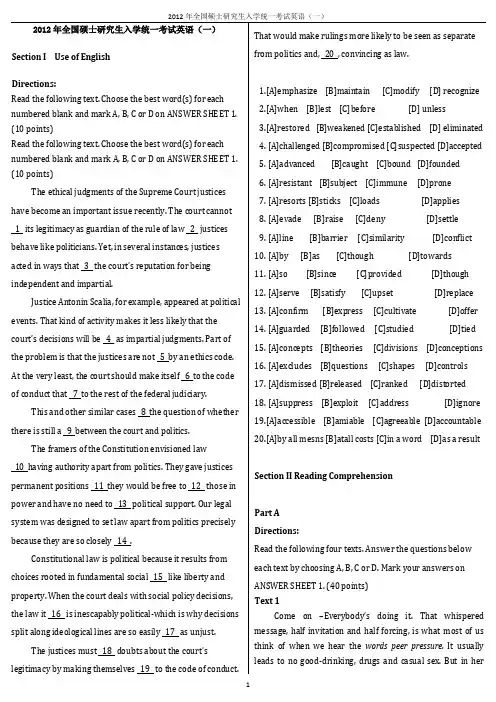
Consequently, discovery claims should be thought of as protoscience. Similar to newly staked mining claims, they are full of potential. But it takes collective scrutiny and acceptance to transform a discovery claim into a mature discovery. This is the credibility process, through which the individual researcher’s me, here, now becomes the community’s anyone, anywhere, anytime. Objective knowledge is the goal, not the starting point.Once a discovery claim becomes public, the discoverer receives intellectual credit. But, unlike with mining claims, the community takes control of what happens next. Within the complex social structure of the scientific community, researchers make discoveries; editors and reviewers act as gatekeepers by controlling the publication process; other scientists use the new finding to suit their own purposes; and finally, the public (including other scientists) receives the new discovery and possibly accompanying technology. As a discovery claim works it through the community, the interaction and confrontation between shared and competing beliefs about the science and the technology involved transforms an individual’s discovery claim into the community’s credible discovery.Two paradoxes exist throughout this credibility process. First, scientific work tends to focus on some aspect of prevailing Knowledge that is viewed as incomplete or incorrect. Little reward accompanies duplication and confirmation of what is already known and believed. The goal is new-search, not re-search. Not surprisingly, newly published discovery claims and credible discoveries that appear to be important and convincing will always be opento challenge and potential modification or refutation by future researchers. Second, novelty itself frequently provokes disbelief. Nobel Laureate and physiologist AlbertAzent-Gyorgyi once described discovery as “seeing what everybody has seen and thinking what nobody has thought.” But thinking what nobody else has thought and telling others what they have missed may not change their views. Sometimes years are required for truly novel discovery claims to be accepted and appreciated.In the end, credibility “happens” to a discovery claim – a process that corresponds to what philosopher Annette Baier has described as the commons of the mind. “We reason together, challenge, revise, and complete each other’s reasoning and each other’s conceptions of reason.”31. According to the first paragraph, the process of discovery is characterized by its[A] uncertainty and complexity.[B] misconception and deceptiveness.[C] logicality and objectivity.[D] systematicness and regularity.32. It can be inferred from Paragraph 2 that credibility process requires[A] strict inspection.[B]shared efforts.[C] individual wisdom.[D]persistent innovation.33.Paragraph 3 shows that a discovery claim becomes credible after it[A] has attracted the attention of the general public.[B]has been examined by the scientific community.[C] has received recognition from editors and reviewers.[D]has been frequently quoted by peer scientists.34. Albert Szent-Györgyi would most likely agree that[A] scientific claims will survive challenges.[B]discoveries today inspire future research.[C] efforts to make discoveries are justified.[D]scientific work calls for a critical mind.35.Which of the following would be the best title of the test?[A] Novelty as an Engine of Scientific Development.[B]Collective Scrutiny in Scientific Discovery.[C] Evolution of Credibility in Doing Science.[D]Challenge to Credibility at the Gate to Science.Text 4If the trade unionist Jimmy Hoffa were alive today, he would probably represent civil servant. When Hoffa’s Teamsters were in their prime in 1960, only one in ten American government workers belonged to a union; now 36% do. In 2009 the number of unionists in America’s public sector passed that of their fellow members in the privatesector. In Britain, more than half of public-sector workers but only about 15% of private-sector ones are unionized.There are three reasons for the public-sector unions’ thriving. First, they can shut things down without suffering much in the way of consequences. Second, they are mostly bright and well-educated. A quarter of America’spublic-sector workers have a university degree. Third, they now dominate left-of-centre politics. Some of their ties go back a long way. Britain’s Labor Party, as its name implies, has long been associated with trade unionism. Its current leader, Ed Miliband, owes his position to votes frompublic-sector unions.At the state level their influence can be even more fearsome. Mark Baldassare of the Public Policy Institute of California points out that much of the state’s budget is patrolled by unions. The teachers’ unions ke ep an eye on schools, the CCPOA on prisons and a variety of labor groups on health care.In many rich countries average wages in the state sector are higher than in the private one. But the real gains come in benefits and work practices. Politicians have repeatedly “backloaded” public-sector pay deals, keeping the pay increases modest but adding to holidays and especially pensions that are already generous.Reform has been vigorously opposed, perhaps most egregiously in education, where charter schools, academies and merit pay all faced drawn-out battles. Even though there is plenty of evidence that the quality of the teachers is the most important variable, teachers’ unions have fought against getting rid of bad ones and promoting good ones.As the cost to everyone else has become clearer, politicians have begun to clamp down. In Wisconsin the unions have rallied thousands of supporters against Scott Walker, the hardline Republican governor. But many within the public sector suffer under the current system, too.John Donahue at Harvard’s Kennedy School points out that the norms of culture in Western civil services suit those who want to stay put but is bad for high achievers. The only American public-sector workers who earn well above $250,000 a year are university sports coaches and the president of the United States. Bankers’ fat pay packets have attracted much criticism, but a public-sector system that does not reward high achievers may be a much bigger problem for America.36. It can be learned from the first paragraph that[A] Teamsters still have a large body of members.[B] Jimmy Hoffa used to work as a civil servant.[C] unions have enlarged their public-sector membership.[D]the government has improved its relationship with unionists.37. Which of the following is true of Paragraph 2?[A] Public-sector unions are prudent in taking actions.[B] Education is required for public-sector union membership.[C] Labor Party has long been fighting against public-sector unions.[D]Public-sector unions seldom get in trouble for their actions.38. It can be learned from Paragraph 4 that the income in the state sector is[A] illegally secured.[B] indirectly augmented.[C] excessively increased.[D]fairly adjusted.39. The example of the unions in Wisconsin shows that unions[A]often run against the current political system.[B]can change people’s political attitudes.[C]may be a barrier to public-sector reforms.[D]are dominant in the government.40. John Donahue’s attitude towards the public-sector system is one of[A]disapproval.[B]appreciation.[C]tolerance.[D]indifference.Part BDirections:In the following text, some sentences have been removed. For Questions 41-45, choose the most suitable one from the list A-G to fit into each of the numbered blanks. There are two【解析】第二段给的具体事例说明,法官出现在政治活动中会使法官形象受损,影响他们独立、公正的名声。
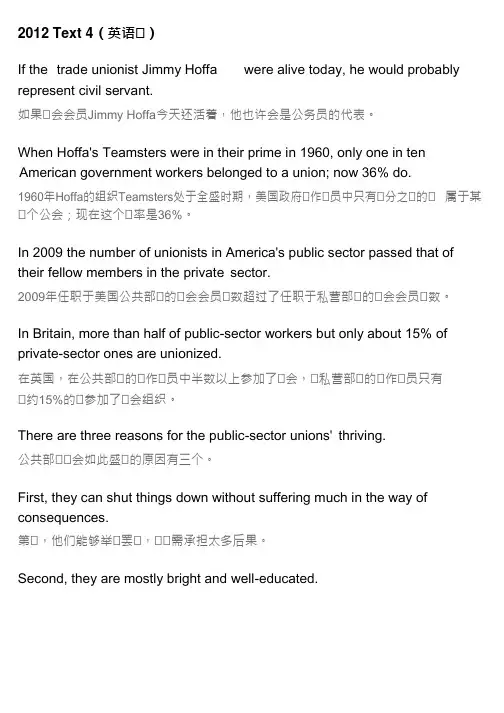
2012 Text 4(英语⼀)If the trade unionist Jimmy Hoffa were alive today, he would probably represent civil servant.如果⼯会会员Jimmy Hoffa今天还活着,他也许会是公务员的代表。
When Hoffa's Teamsters were in their prime in 1960, only one in ten American government workers belonged to a union; now 36% do.1960年Hoffa的组织Teamsters处于全盛时期,美国政府⼯作⼯员中只有⼯分之⼯的⼯属于某⼯个公会;现在这个⼯率是36%。
In 2009 the number of unionists in America's public sector passed that of their fellow members in the private sector.2009年任职于美国公共部⼯的⼯会会员⼯数超过了任职于私营部⼯的⼯会会员⼯数。
In Britain, more than half of public-sector workers but only about 15% of private-sector ones are unionized.在英国,在公共部⼯的⼯作⼯员中半数以上参加了⼯会,⼯私营部⼯的⼯作⼯员只有⼯约15%的⼯参加了⼯会组织。
There are three reasons for the public-sector unions' thriving.公共部⼯⼯会如此盛⼯的原因有三个。
First, they can shut things down without suffering much in the way of consequences.第⼯,他们能够举⼯罢⼯,⼯⼯需承担太多后果。
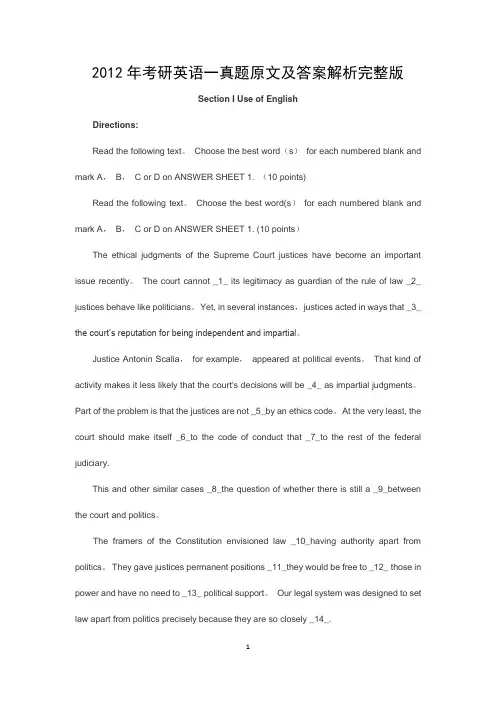
2012年考研英语一真题原文及答案解析完整版Section I Use of EnglishDirections:Read the following text。
Choose the best word(s)for each numbered blank and mark A,B,C or D on ANSWER SHEET 1. (10 points)Read the following text。
Choose the best word(s)for each numbered blank and mark A,B,C or D on ANSWER SHEET 1. (10 points)The ethical judgments of the Supreme Court justices have become an important issue recently。
The court cannot _1_ its legitimacy as guardian of the rule of law _2_ justices behave like politicians。
Yet, in several instances,justices acted in ways that _3_ the court’s reputation for being independent and impartial。
Justice Antonin Scalia,for example,appeared at political events。
That kind of activity makes it less likely that the court's decisions will be _4_ as impartial judgments。
Part of the problem is that the justices are not _5_by an ethics code。

“来吧,大家都在这样做”,这句低声说出的话,有一半成分是邀请,一半是强迫,在听到“朋友压力”这个词时,大多数人会想到这句话。
这句话通常会导致毫无益处的事情——饮酒,吸毒以及随意的性行为。
在缇娜·罗森博格的新书《加入俱乐部》中认为同辈压力通过她所谓的“社会治愈”也可以成为一种积极的力量,在这种治愈中组织和官员可以利用这种集体动力的能量帮助提高人们的生活,甚至是那句话。
罗森博格是普利策奖的获得者,她列举了许多在运转的社会治愈的例子:在南卡罗莱纳州发起了一个叫做强烈反对烟雾的反吸烟项目,目的是使香烟不再酷。
在南美,发起了一个叫做热爱生活的艾滋预防项目,招募了年轻人在他们的朋友中宣传性安全。
这个想法似乎是可行的,她是一个有感知力的观察者。
他对于公共健康活动的软弱无力做出的评论正中要点:他们没有将同辈压力转变为健康的习惯,而且他们显示出了一种对心理学严重错误的理解。
“你敢与众不同吗,那就不要吸烟!”兴起了一个以在青年人中减少吸烟为目的的标语运动,这些青年人想做的只是融入。
罗森博格的建议令人信服:公共健康支持者应该向广告商取经,他们很擅长于应用同辈压力。
但对于社会治愈的综合效力,罗森博格并没有说服力。
她的书中充满了太多无关的细节,没有足够的社会和生物原因来解释同辈压力为何如此巨大。
我们可以看出社会治愈最明显的缺陷就是,从长期来看,它的作用并不好。
一旦资金被削减,反烟运动就会失败。
只有有限的和杂乱的证据可以证明热爱生活运动可以引起长远的改变。
毫无疑问我们的朋友圈对我们的行为产生巨大的影响。
一个新出现的研究机构表示,积极健康和坏习惯都通过社交在朋友圈中传播。
这是同辈压力一个隐秘的形式:我们会无意识的模仿我们每天看到的行为。
然而,很不确定的是,专家和官员如何能通过选择朋友圈来成功控制人们的行为使其朝着准确正确的方向。
这就像老师将后排惹是生非的学生群分开,让他们与好学生坐一起。
这种策略从来没有有效过。
而这也是从外部进行社会治愈所面临的一个问题:在现实生活中,朋友是个人的选择,而不是外部的分配。
一. 完型填空1--5 BABDC 6--10 BDBAB 11--15 ACCDA 16--20 CACDD二. 阅读答案21--25 DBACD 26--30 CDADA 31--35 ABBDC 36--40 CDBCA三. 新题型答案41. C 42. D 43. A 44. F 45. G四. 翻译参考译文46. 在物理学上,一种方法(物理学上的一种方法)把这种统一性的冲动发挥到了极点,并努力寻找一种万能的理论,即唯一的一条为我们都明白的一切东西所创造或生成的公式/方法。
47. 在这里,达尔文的理论似乎提供了一个理由或依据,因为如果所有的人类都有共同的起源,那么文化多样性也能够追溯到更多可控的起源,持这样的观点似乎是有道理的。
48. 从我们的共性中过滤出独特性能够让我们理解复杂的文化行为是怎样出现的,以及用进化或认知的概念来说,是什么在引导这种文化行为。
49.由约华格林伯根提出的第二个观点,采取了一个更为经验主义的普遍性方法,识别出了许多语言所共有的特征(特别是词序方面),这些特征被认为是代表了由认知限制所造成的偏见。
50. 乔姆斯基的语法应该说明了语言变化的模式,这些模式和语言这个家族或通过这个家族所追溯的这个路径是无关的,而格林伯根的普遍性预测了某些特定词序关系之间紧密的相互依赖性。
五. 作文参考范文51. 小作文参考范文(参见作文冲刺班课程授课内容和讲义第24页写法)Dear my friends,I am writing this letter to welcome you to our university on behalf of our Students’ Union. I expect you to arrive here with increasing joy as well as excitement. It is of great pleasure to anticipate your coming soon.As foreign students, you will find everything on our campus quite different, fresh and alien. Therefore, after arriving, you can take full advantage of every opportunity to communicate with us directly to bridge the gap. To be more specific, the climate in Beijing is considerably different from your hometown, but you will soon get accustomed to living here. Finally, I hope to accompany you and introduce some special or unique campus characteristics and cultures so as to let you be better acquainted with/understand our campus life.We shall strive to make your stay or visit as pleasant as possible by providing the best service as well as support for you. All of our students are looking forward to your early coming eagerly.Yours sincerely,Li Ming52. 大作文 Sample WritingAs is apparently drawn in this miniature, in the middle stand two individuals, one feeling gloomy while the other optimistic. The Chinese characters above inform our readers of the message that various folks take different attitudes toward the same event. (参见黄涛冲刺班作文讲义第8页第一段首句必杀句型)How impressive this drawing seems to be in depicting one of the most prevalent themes that attitudes make everything in our life.After careful reflection and mediation, we examinees come to understand the enlightening drawing. I contend that this thought-provoking image conveys one profound layer of implication concerning attitude or optimism. It is universally acknowledged that life is by no means perfect and whether we feel optimistic or not depends on what attitudes we take. (参见黄涛冲刺班讲义第3页作文经典句型必备)When confronted with an adverse situation, some youths feel in low spirits and fall into depression. Others, on the contrary, look at the positive side of the situation and remain cheerful. As a consequence, it is our attitude rather than the situation itself that determines how we feel. (参见启航冲刺讲义第13页第30个段落正反论证法)In my personal sense, the message applies to our youths especially. In such a rat-race society, everyone is bound to encounter hardships and difficulties. In this sense, I should keep an optimistic attitude to pullthrough any hardship. Just as a famous figure puts it, it is our attitude that has changed everything in our life. (参见作文冲刺讲义第7页作文九大高分句式之引用名人名言)更多经典高分句型可以参考40页的黄涛作文冲刺资料,按照自己喜欢的背诵的高分句子来造就自己的高分作文。
2012Text 1Come on –Everybody’s doing it. That whispered message, half invitation and half forcing, is what most of us think of when we hear the words peer pressure. It usually leads to no good-drinking, drugs and casual sex. But in her new book Join the Club, Tina Rosenberg contends that peer pressure can also be a positive force through what she calls the social cure, in which organizations and officials use the power of group dynamics to help individuals improve their lives and possibly the word.得了吧, 每个人都这样啊. 这种说法一半是邀请,一半是强制。
当我们听到“同辈(趋同)压力”这个词组的时候我们想到的就是这种说法。
这种信息一般让人想到不好的事情,比如喝酒,吸毒,一夜情。
但是,在她的新书《参加这个俱乐部》, Tina Rosenberg认为,纯粹压力也是一种积极的力量,通过她所说的社会治疗,公司和官方人员可以使用群体力量去帮助个人提高他们的生活,而且也有可能提高整个人类世界的生活。
Rosenberg, the recipient of a Pulitzer Prize, offers a host of example of the social cure in action: In South Carolina, a state-sponsored antismoking program called Rage Against the Haze sets out to make cigarettes uncool. In South Africa, an HIV-prevention initiative known as LoveLife recruits young people to promote safe sex among their peers.Rosenberg是普利策奖获得者,他提供了许多社会治疗的例子:在南卡罗莱纳州,一个州资助的反对抽烟的项目叫做“向烟雾宣战”就旨在控制好烟草销售。
2012考研英语一翻译部分原文全文译文2012年研究生入学考试英语(一)翻译部分全文译文Universal Truths普遍真理薛海滨译译者注:本文选自英国《自然》杂志(原文详见472136a.html),2012年研究生考试中,出题人对原文的某些字句进行了改编。
在此,译者翻译的是没有经过改编的原版文章。
Since at least the days of Aristotle, a search for universal principles has characterized the scientific enterprise. In some ways, this quest for commonalities defines science: without it, there is no underlying order and pattern, merely as many explanations as there are things in the world. Newton's laws of motion, the oxygen theory of combustion and Darwinian evolution each bind a host of different phenomena into a single explicatory framework.至少是从亚里士多德时代开始,科学探索的主要特点是寻求普遍规律。
从某种程度上讲,科学就是探索共性:没有共性的探究,就无从发现科学的基本规律和模式,其结果是有多少种事物,就有多少种解释。
无论是牛顿的运动定律,还是燃烧氧化学说,还是达尔文的进化论,无不是汇不同的现象于统一的解释。
(46)In physics, one approach takes this impulse for unification to its extreme, and seeks a theory of everything — a single generative equation for all we see. It is becoming less clear, however, that such a theory would be a simplification, given the proliferation of dimensions and universes that it might entail. Nonetheless, unification of sorts remains a major goal.物理学中,有一种方法将这种对统一性的紧迫需求发挥到了极致,追求一种具有普遍意义的理论,即为我们所见之物寻求一种单一的生成公式。
2012英语一阅读Text 11---Come on——Everybody’s doing it. That whispered message, half invitation and half forcing, is what most of us think of when we hear the words peer pressure. It usually leads to no good —— drinking, drugs and casual sex. But in her new book Join the Club, Tina Rosenberg contends that peer pressure can also be a positive force through what she calls the social cure, in which organizations and officials use the power of group dynamics to help individuals improve their lives and possibly the world.得了吧,每个人都这样啊. 这种说法一半是邀请,一半是强制。
当我们听到―同辈(趋同)压力‖这个词组的时候我们想到的就是这种说法。
这种信息一般让人想到不好的事情,比如喝酒,吸毒,一夜情。
但是,在她的新书《参加这个俱乐部》, Tina Rosenberg认为,纯粹压力也是一种积极的力量,通过她所说的社会治疗,公司和官方人员可以使用群体力量去帮助个人提高他们的生活,而且也有可能提高整个人类世界的生活。
21. According to the first paragraph, peer pressure often emerges as[A] a supplement to the social cure (根据Tina Rosenberg)[B] a stimulus to group dynamics (逻辑错误)[C] an obstacle to school progress 无中生有[D] a cause of undesirable behaviors √2---Rosenberg, the recipient of a Pulitzer Prize, offers a host of example of the social cure in action: In South Carolina, a state-sponsored antismoking program called Rage Against the Haze sets out to make cigarettes uncool. In South Africa, an HIV-prevention initiative known as LoveLife recruits young people to promote safe sex among their peers.Rosenberg是普利策奖获得者,他提供了许多社会治疗的例子:在南卡罗莱纳州,一个州资助的反对抽烟的项目叫做―向烟雾宣战‖就旨在控制好烟草销售。
TEXT 1Come on –Everybody’s doing it. That whispered message, half invitation and half forcing(强制), is what most of us think of when we hear the words peer pressure(同伴的压力). It usually leads to no good-drinking, drugs and casual(随意的)sex. But in her new book Join the Club, Tina Rosenberg contend sthat peer pressure can also be a positive force through what she calls the social cure(社会治疗), in which organizations and officials use the power of group dynamics to help individuals improve their lives and possibly the world.Rosenberg, the recipient(接受者;受领者;接受器,容器[(+of)])of a Pulitzer Prize(普利策奖), offers a host(许多,主人)of 【a host of:表许多(+名词单数)】example of the social cure in action(在行动): In South Carolina, a state-sponsored(赞助的,发起的)antismoking (禁止吸烟)program called Rage(愤怒【fly into a rage:勃然大怒】)Against the Haze(n.&v.阴霾,疑惑;使朦胧,使糊涂)sets out to make cigarettes uncool(粗野的,没把握的,不冷静沉着的,土里土气的). In South Africa, an HIV-prevention([pri'venʃən])initiative(主动权,首创精神)known as LoveLife recruits young people to promote safe sex among their peers.The idea seems promising(有希望的,有前途的),and Rosenberg is a perceptive(感知的,有知觉力的)observer. Her critique([krɪ'tik] 批评,评论,评论文章)of the lameness (残废,跛【lame而易见的??): they fail to mobilize(pressure for healthy habits, and they demonstrate a seriously flawed understanding of告牌)campaign aimed at reducing smoking among teenagers-teenagers, who desire nothing more than fitting in. Rosenberg argues convincingly that public-health advocates ought to take a page(学习,模仿)from advertisers, so skilled at applying peer pressure.But on the general effectiveness(一般的有效性)of the social cure, Rosenberg is less persuasive. Join the Club is filled with too much irrelevant detail and not enough exploration of the social and biological factors that make peer pressure so powerful. The most glaring(1. 耀眼的;闪耀的2. 瞪视的;炯炯的)flaw(【the most glaring flaw:最明显的缺点】)of the social cure as it’s presented here is that it doesn’t work very well for very long. Rage Against the Haze failed once state funding was cut. Evidence that the LoveLife program produces lasting changes is limited and mixed.There’s no doubt that our peer groups exert enormous influence on our behavior【exert…on:运用…在…上】. An emerging((用作定语)新兴的) body(【新兴体】) of research shows that positive health habits-as well as negative ones-spread through networks of friends via social communication. This is a subtle form of peer pressure: we unconsciously imitate the behavior we see every day.Far less certain(不确定的), however, is how successfully experts and bureaucrats(['bjurə,kræt] 官僚,官僚主义者)can select our peer groups and steer (1. 掌(船)舵,驾驶[O]2. 指导;带领;操纵[O]3. 沿着...前进,遵循)their activities in virtuous(['vɝtʃuəs] 1. 有道德的;善良的;正直的2. 贞洁的)directions. It’s like the teacher who breaks up(崩溃;分离;解散;结业)the troublemakers in the back row(在后排)by pairing ((演出、比赛等的)双人,双档;配档)them with better-behaved classmates. The tactic(战术;策略;手法)never really works. And that’sthe problem with a social cure engineered from the outside: in the real world, as in school, we insist on choosing our own friends.。
2012Text 1Come on –Everybody’s doing it. That whispered message, half invitation and half forcing, is what most of us think of when we hear the words peer pressure. It usually leads to no good-drinking, drugs and casual sex. But in her new book Join the Club, Tina Rosenberg contends that peer pressure can also be a positive force through what she calls the social cure, in which organizations and officials use the power of group dynamics to help individuals improve their lives and possibly the word.得了吧, 每个人都这样啊. 这种说法一半是邀请,一半是强制。
当我们听到“同辈(趋同)压力”这个词组的时候我们想到的就是这种说法。
这种信息一般让人想到不好的事情,比如喝酒,吸毒,一夜情。
但是,在她的新书《参加这个俱乐部》, Tina Rosenberg认为,纯粹压力也是一种积极的力量,通过她所说的社会治疗,公司和官方人员可以使用群体力量去帮助个人提高他们的生活,而且也有可能提高整个人类世界的生活。
Rosenberg, the recipient of a Pulitzer Prize, offers a host of example of the social cure in action: In South Carolina, a state-sponsored antismoking program called Rage Against the Haze sets out to make cigarettes uncool. In South Africa, an HIV-prevention initiative known as LoveLife recruits young people to promote safe sex among their peers.Rosenberg是普利策奖获得者,他提供了许多社会治疗的例子:在南卡罗莱纳州,一个州资助的反对抽烟的项目叫做“向烟雾宣战”就旨在控制好烟草销售。
2012Text 1Come on –Everybody’s doing it. That whispered message, half invitation and half forcing, is what most of us think of when we hear the words peer pressure. It usually leads to no good-drinking, drugs and casual sex. But in her new book Join the Club, Tina Rosenberg contends that peer pressure can also be a positive force through what she calls the social cure, in which organizations and officials use the power of group dynamics to help individuals improve their lives and possibly the word.得了吧, 每个人都这样啊. 这种说法一半是邀请,一半是强制。
当我们听到“同辈(趋同)压力”这个词组的时候我们想到的就是这种说法。
这种信息一般让人想到不好的事情,比如喝酒,吸毒,一夜情。
但是,在她的新书《参加这个俱乐部》, Tina Rosenberg认为,纯粹压力也是一种积极的力量,通过她所说的社会治疗,公司和官方人员可以使用群体力量去帮助个人提高他们的生活,而且也有可能提高整个人类世界的生活。
Rosenberg, the recipient of a Pulitzer Prize, offers a host of example of the social cure in action: In South Carolina, a state-sponsored antismoking program called Rage Against the Haze sets out to make cigarettes uncool. In South Africa, an HIV-prevention initiative known as LoveLife recruits young people to promote safe sex among their peers.Rosenberg是普利策奖获得者,他提供了许多社会治疗的例子:在南卡罗莱纳州,一个州资助的反对抽烟的项目叫做“向烟雾宣战”就旨在控制好烟草销售。
在南非,预防HIV,即众所周知的“热爱生命”活动要求年轻人要安全性生活。
The idea seems promising,and Rosenberg is a perceptive observer. Her critique of the lameness of many pubic-health campaigns is spot-on: they fail to mobilize peer pressure for healthy habits, and they demonstrate a seriously flawed understanding of psychology.” Dare to be different, please don’t smoke!” pleads one billboard campaign aimed at reducing smoking among teenagers-teenagers, who desire nothing more than fitting in. Rosenberg argues convincingly that public-health advocates ought to take a page from advertisers, so skilled at applying peer pressure.这个观点似乎很有希望,而且Rosenberg是个敏锐的观察家。
她对于许多公共健康活动缺点的批评是中肯的:他们没能动员同辈压力来建立健康的习惯,他们展示的是对心理学的严重误解。
一个旨在在青少年中禁烟的广告牌写着:“就敢与众不同,请勿吸烟!”青少年最渴望的是融入群体。
Rosenberg认为,公共健康建议应该效仿广告商,广告商懂得如何应用同辈压力。
But on the general effectiveness of the social cure, Rosenberg is less persuasive. Join the Club is filled with too much irrelevant detail and not enough exploration of the social and biological factors that make peer pressure so powerful. The most glaring flaw of th e social cure as it’s presented here is that it doesn’t work very well for very long. Rage Against the Haze failed once state funding was cut. Evidence that the LoveLife program produces lasting changes is limited and mixed.但对于社会治疗的广泛效果,Rosenberg就没有那么有说服力了。
《加入俱乐部》一书写了太多无关细节,没有认真探讨社会和生物因素,这些因素能使同辈压力变得很有影响力。
这里说的社会治疗的明显缺点是它有效期不长。
一旦资金来源消失,那么“向烟雾宣战”的活动就会失败。
“热爱生命”活动能产生持久的影响这种说法的证据不足。
There’s no doubt that our peer groups exert enormous influence on our behavior. An emerging body of research shows that positive health habits-as well as negative ones-spread through networks of friends via social communication. This is a subtle form of peer pressure: we unconsciously imitate the behavior we see every day.毫无疑问,我们的同龄人会对我们的行为产生巨大影响。
研究显示,积极的健康习惯,以及负面的习惯,会通过社会交流在朋友之间传播。
这是同辈压力的一种微妙的形式:我们会无意识模仿我们每天看到的行为。
Far less certain, however, is how successfully experts and bureaucrats can select our peer groups and steer their activities in virtuous directions. It’s like the teacher who breaks up the troublemakers in the back row by pairing them with better-behaved classmates. The tactic never really works. And that’s the problem with a social cure engineered from the outside: in the real world, as in school, we insist on choosing our own friends.但是,很难确定的是,专家和官员能否成功选择我们的同辈,控制好他们的行为能在道德的道路上发展。
这就像老师,通过让问题学生和好学生坐在一起的方法,让后排学生不要凑在一起胡闹。
这种方法从来就没有什么收效。
这就是从外界设计出的社会治疗会产生问题所在:在真实的社会里,正如在学校,我们坚持会选择自己的朋友。
Text 2A deal is a deal-except, apparently, when Entergy is involved. The company, a major energy supplier in New England, provoked justified outrage in Vermont last week when it announced it was reneging on a longstanding commitment to abide by the strict nuclear regulations.说好的是不能改变的! 除非Entergy进行的交易。
这个公司是新英格兰地区主要的能源提供商,该公司引起了佛蒙特州人们的义愤,因为上周它宣称它不想遵守严格的核能规定。
Instead, the company has done precisely what it had long promised it would not challenge the constitutionality of Vermont’s rules in the federal court, as part of a desperate effort to keep its Vermont Yankee nuclear power plant running. It’s a stunning move.相反,该公司一直履行了它早先的承诺过不做的事情:即它不会因为想保持其Vermont Yankee核电站持续经营,而要在联邦法院挑战该州相关规定的合法性(宪法)。
现在这个做法让人震惊。
The conflict has been surfacing since 2002, when the corporation bought Vermont’s only nuclear power plant, an aging reactor in Vernon. As a condition of receiving state approval for the sale, the company agreed to seek permission from state regulators to operate past 2012. In 2006, the state went a step further, requiring that any extension of the plant’s license be subject to Vermont legislature’s approval. Then, too, the company went along.这个冲突始于2002,当时该公司购买了佛蒙特州唯一一家核电站,其实是一个位于Vernon的破旧反应堆。